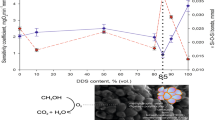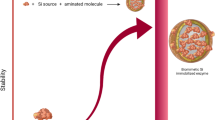Abstract
Immobilized bacteria are being extensively used for metabolite production, biocatalysts, and biosensor construction. However, long-term viability and metabolic activity of entrapped bacteria is affected by several conditions such as their physiological state, the presence of high-osmolarity environments, porous structure and shrinkage of the matrix. The aim of this work was to evaluate the effect of various parameters on bacteria immobilized in sol–gel-derived silica matrices. With this purpose, we evaluated the stress of immobilization over bacteria cultures obtained from different growing states, the effect of cell density and bacteria capability to proliferate inside matrices. Best results to attain longer preservation times were obtained when we immobilized suspensions with an optimized bacterial number of 1 × 107 cfu/gel in the presence of LB medium using aqueous silica precursors. Furthermore, the impact of osmotic stress with the subsequent intracellular trehalose accumulation and the addition of osmolites were investigated. Shorter preservation times were found for bacteria immobilized in the presence of osmolites while trehalose accumulation in stressed cells did not produce changes on entrapped bacteria viability. Finally, nutrient addition in silica matrices was studied indicating that the presence of a carbon source without the simultaneous addition of nitrogen was detrimental for immobilized E. coli. However, when both carbon and nitrogen sources were present, bacteria were able to survive longer periods of time.







Similar content being viewed by others
References
Alvarez GS, Desimone MF, Diaz LE (2007) Immobilization of bacteria in silica matrices using citric acid in the sol–gel process. Appl Microbiol Biotechnol 73:1059–1064
Benaroudj N, Lee DH, Goldberg AL (2001) Trehalose accumulation during cellular stress protects cells and cellular proteins from damage by oxygen radicals. J Biol Chem 276:24261–24267
Bottcher H, Soltmann U, Mertig M, Pompe W (2004) Biocers: ceramics with incorporated microorganisms for biocatalytic, biosorptive and functional materials development. J Mater Chem 14:2176–2188
Brauer MJ, Yuan J, Bennett BD, Lu W, Kimball E, Botstein D, Rabinowitz JD (2006) Conservation of the metabolomic response to starvation across two divergent microbes. Proc Natl Acad Sci USA 103:19302–19307
Champagne CP, Gardner NJ (2001) The effect of protective ingredients on the survival of immobilized cells of Streptococcus thermophilus to air and freeze-drying Electronic Journal of Biotechnology ISSN: 0717-3458 4 No3
Coiffier A, Coradin T, Roux C, Bouvet OMM, Livage J (2001) Sol–gel encapsulation of bacteria: a comparison between alkoxide and aqueous routes. J Mater Chem 11:2039–2044
Desimone MF, Degrossi J, D'Aquino M, Diaz LE (2002) Ethanol tolerance in free and sol–gel immobilised Saccharomyces cerevisiae. Biotechnol Let 24:1557–1559
Desimone MF, De Marzi MC, Copello GJ, Fernandez MM, Malchiodi EL, Diaz LE (2005) Efficient preservation in a silicon oxide matrix of Escherichia coli, producer of recombinant proteins. Appl Microbiol Biotechnol 68:747–752
Desimone MF, De Marzi MC, Copello GJ, Fernández MM, Pieckenstain FL, Malchiodi EL, Diaz LE (2006) Production of recombinant proteins by sol–gel immobilized Escherichia coli. Enz Microb Technol 40:168–171
Desimone MF, Matiacevich SB, Buera MP, Díaz LE (2008) Effects of relative humidity on enzyme activity immobilized in sol–gel-derived silica nanocomposites. Enz Microb Technol 42:583–588
Ferrer ML, Garcia-Carvajal ZY, Yuste L, Rojo F, delMonte F (2006) Bacteria viability in sol–gel materials revisited: cryo-SEM as a suitable tool to study the structural integrity of encapsulated bacteria. Chem Mater 18:1458–1463
Hempfling WP, Mainzer SE (1975) Effects of varying the carbon source limiting growth on yield and maintenance characteristics of Escherichia coli in continuous culture. J Bacteriol 123:1076–1087
Kabir MS, Sagara T, Oshima T, Kawagoe Y, Mori H, Tsunedomi R, Yamada M (2004) Effects of mutations in the rpoS gene on cell viability and global gene expression under nitrogen starvation in Escherichia coli. Microbiol 150:2543–2553
Kandror O, DeLeon A, Goldberg AL (2002) Trehalose synthesis is induced upon exposure of Escherichia coli to cold and is essential for viability at low temperatures. Proc Natl Acad Sci USA 99:9727–9732
Lawrence CL, Botting CH, Antrobus R, Coote PJ (2004) Evidence of a new role for the high-osmolarity glycerol mitogen-activated protein kinase pathway in yeast: regulating adaptation to citric acid stress. Mol Cell Biol 24:3307–3323
Lillie SM, Pringle JR (1980) Reserve carbohydrate metabolism in S. cerevisiae: response to nutrient limitation. J Bacteriol 143:1384–1394
Livage J, Coradin T (2006) Living cells in oxide glasses. Rev Miner Geochem 64:315–332
Murarka A, Dharmadi Y, Yazdani SS, Gonzalez R (2007) Fermentative utilization of glycerol in Escherichia coli and its implications for the production of fuels and reduced chemicals. Appl Environ Microbiol:AEM.02192-02107
Naskar MK (2005) Effects of organic acids on sol–gel transition of silicic acid—a rheological study. J Mater Sci 40:1309–1311
Nassif N, Bouvet OMM, Noelle Rager M, Roux C, Coradin T, Livage J (2002) Living bacteria in silica gels. Nat Mater 1:42–44
Nassif N, Roux C, Coradin T, Rager MN, Bouvet OMM, Livage J (2003) A sol–gel matrix to preserve the viability of encapsulated bacteria. J Mater Chem 13:203–208
Oren A (2003) Organic compatible solutes. In: Springer (ed) Halophilic microorganisms and their environments, Vol 5. Netherlands, p 279–305
Stewart PS, Robertson CR (1989) Microbial growth in a fixed volume: studies with entrapped Escherichia coli. Appl Microbiol Biotechnol 30:34–40
Styrvold OB, Strom AR (1991) Synthesis, accumulation, and excretion of trehalose in osmotically stressed Escherichia coli K-12 strains: influence of amber suppressors and function of the periplasmic trehalase. J Bacteriol 173:1187–1192
Sun Z-j, Lv G-j, Li S-y, Yu W-t, Wang W, Xie Y-b, Ma X (2007) Differential role of microenvironment in microencapsulation for improved cell tolerance to stress. Appl Microbiol Biotechnol 75:1419–1427
Tessema DA, Rosen R, Pedazur R, Belkin S, Gun J, Ekeltchik I, Lev O (2006) Freeze-drying of sol–gel encapsulated recombinant bioluminescent E. coli by using lyo-protectants. Sens Actuators, B, Chem 113:768–773
Welsh DT, Herbert RA (1999) Osmotically induced intracellular trehalose, but not glycine betaine accumulation promotes desiccation tolerance in Escherichia coli. FEMS Microbiol Let 174:57–63
Acknowledgments
G.S.A. is grateful for her doctoral fellowship granted by the National Research Council (CONICET). M.L.F is grateful for her undergraduate fellowship granted by the University of Buenos Aires. The authors would like to acknowledge the support of grants from the Universidad of Buenos Aires UBACYT B049 (L.E.D.) and B407 (M.F.D.), and Agencia Nacional de Investigaciones Científicas y Técnicas BID 1728/OC-AR PICT 14192 (L.E.D.) and 32310 (M.F.D.).
Author information
Authors and Affiliations
Corresponding author
Rights and permissions
About this article
Cite this article
Alvarez, G.S., Foglia, M.L., Copello, G.J. et al. Effect of various parameters on viability and growth of bacteria immobilized in sol–gel-derived silica matrices. Appl Microbiol Biotechnol 82, 639–646 (2009). https://doi.org/10.1007/s00253-008-1783-9
Received:
Revised:
Accepted:
Published:
Issue Date:
DOI: https://doi.org/10.1007/s00253-008-1783-9




